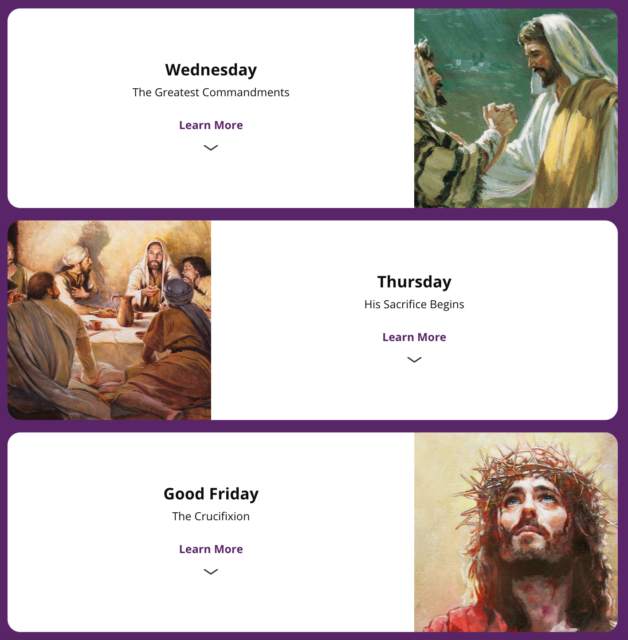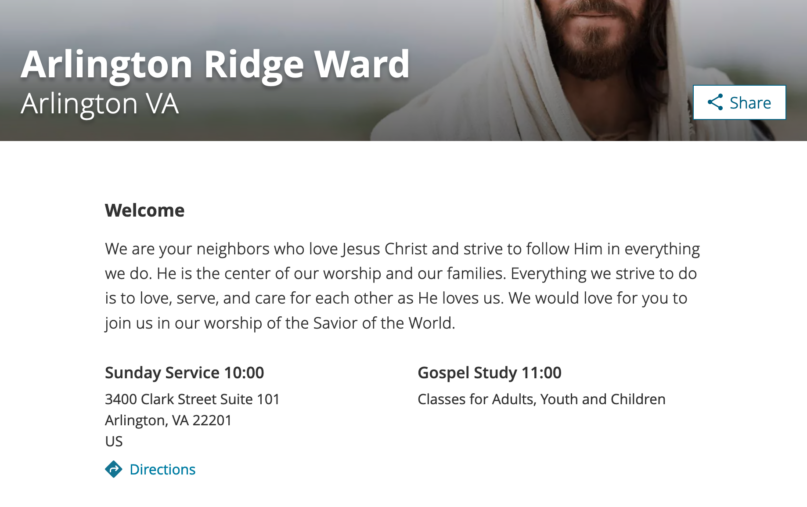(RNS) — Tomorrow, all around the world, members of the Church of Jesus Christ will not have Sunday School, Relief Society or priesthood meetings. Children and youth will not meet in the second hour of church.
In fact, there will be no second hour of church, because the First Presidency has canceled it so we can all focus on a more Christ-centered Easter. Each ward or branch will hold a special Easter sacrament meeting that is centered on Jesus, and then we’re to go to our own homes and celebrate Easter as the most important Christian holy day of the year.
Easter is getting the full-court press from the church this year, with suggestions on the church’s website for teaching kids about its sacred meaning, creating Christ-centered Easter traditions with our families and recipes for special Easter treats.

A Holy Week and Easter banner from the website of the Church of Jesus Christ of Latter-day Saints. April 7, 2023. Screen grab
The Easter emphasis has been building for some time (though canceling the second hour of church takes it to a whole new level, since we almost never do that). Indeed, almost all of the links to activity suggestions and other resources have been culled from the church’s magazines from the last two decades.
I’ve been delighted to witness the change. I can remember plenty of sacrament meetings in earlier years when we didn’t discuss Easter at all. No special music, no retelling of the empty tomb. It felt impoverished to sit in the pews on what was supposed to be the holiest day of the Christian calendar and hear a prosaic talk on why we should rotate the items in our food storage. (Yes, that happened.)
So we’ve been moving for some time toward recognizing Easter, but this year it has expanded to include all of Holy Week.
The very first talk in General Conference last week, from Elder Gary Stevenson, said that Easter worship not only includes Easter Day itself, but recognition of the days leading up to it. “This includes a greater and more thoughtful recognition of Palm Sunday and Good Friday as practiced by some of our Christian cousins,” he said. He then suggested that “we might also adopt appropriate Christ-centered Easter traditions found in the cultures and practices of countries worldwide.”
He wasn’t the only one to mention Palm Sunday. One person’s overview of General Conference said it came up four times over the course of the weekend. Elder Ronald Rasband even spoke about what happens on Palm Sunday, telling a story about being in Ghana one Sunday to divide a stake and being pleasantly surprised to see out the window Christians from another church “joyfully walking down the street waving palms in their hands,” in memory of Jesus’ entry into Jerusalem.
In the past, the church has deliberately de-emphasized Christ’s suffering on the cross, preferring to focus instead on the triumph of his resurrection. I’ve complained before that Easter for us has seemed to come out of nowhere each year, because we never had a way of liturgically marking that Jesus got so much as a chest cold on Friday before rising from the dead on Sunday.
The church’s website now has a Holy Week lectionary of sorts, though it doesn’t use the word “lectionary.” Readings are parsed out for each day of Holy Week, with the exhortation to “grow your relationship with Jesus Christ during Holy Week.”
It also says to “learn more about Jesus Christ by meeting with the missionaries,” suggesting that the intended audience for the page is not current members of the church, but prospective converts. All of the Scripture passages are from the New Testament and none from the Book of Mormon, even though at conference last weekend, Elder Stevenson extolled the Book of Mormon as “a gift of unique witness, another testament of the Easter miracle that contains perhaps the most magnificent Easter Scriptures in all of Christianity.”

A lectionary-like reading plan on the church’s website takes members and prospective converts through each day of Holy Week, using passages from the New Testament. April 7, 2023. Screen grab
Some of the messaging from the church about Easter is clearly directed toward members, asking us to give more attention to Christ and his atonement. But some of it is a protestantized missionary campaign, eliminating anything that makes us look different from other churches.
Recently a reader alerted me to a pilot program the church is instituting in some locations, such as this one in Arlington, Virginia. The program revamps a ward’s website to make it more user-friendly and to allow members and non-members alike to RSVP for activities.
This pilot ward’s webpage is devoid of distinctive language that may be confusing to outsiders. “Sacrament meeting” has become “Sunday services,” while “priesthood and Relief Society” are now “Gospel study.” In a letter to that ward explaining the new site, it was made clear that the goal was to appear to be “more inclusive and hopefully capture a wider audience” of prospective converts. “Previous areas who have utilized this ward webpage have had significantly higher baptism rates and have had impactful experiences gathering and connecting with their ward and community.”

A pilot program website for the Church of Jesus Christ of Latter-day Saints, aimed at becoming more user-friendly for outsiders. April 7, 2023. Screen grab
While I think it’s terrific that our church has worked hard in recent years to be more legible to outsiders (e.g., getting rid of “Beehive” to describe 12-year-old girls), I hope the recent move to embrace Holy Week doesn’t only arise out of a larger “we’re not weird, please like us” campaign. I want to feel that the move toward celebrating Holy Week and Easter is truly about getting to know Jesus more, rather than one facet of an ongoing quest for assimilation.
Whatever the motivation, a funny thing can happen when you start acknowledging that Jesus not only rose in triumph on Sunday but suffered terribly on the cross before that — that there was a time he felt abandoned and alone.
Your view of suffering begins to change. The Shiny Happy Gospel that emphasizes success and self-improvement gives way to a deeper understanding of what 2 Nephi is trying to tell us: Not just that human beings exist “that they might have joy” (v. 25), which is the part of the Scripture we love and put on memes, but also that we can’t have joy without knowing misery (v. 23).
In Holy Week, we relive all of it together, and it changes us from the inside out.
Related content:
Oh, now I get it: Purging the word “Mormon” is a bid for the mainstream






